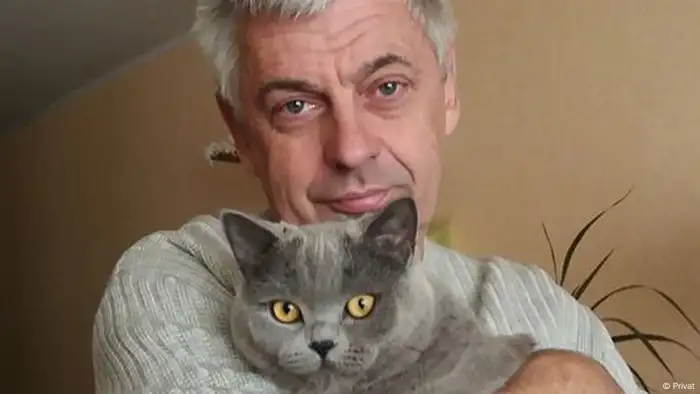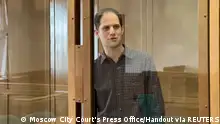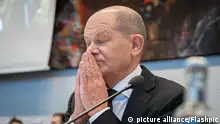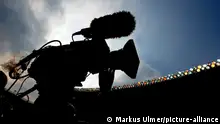Europe
Investigative journalism is a dangerous job in Ukraine
Another journalist is fighting for his life in Ukraine after a brutal attack; Vadym Komarov had just promised incendiary new findings. Ukraine's reporters lament the lack of protection and the legal system's failings.
Vadym Komarov is not the type to stay silent. In the sleepy provincial capital city of Cherkasy, three hours south by car from Kyiv, there are few journalists who scrutinize local authorities and oligarchs.
But Komarov does; he is probably the most determined of them all. For years he shone a light on misconduct in the construction and health sectors and corruption in local politics.
On his Facebook page last weekend, the journalist announced that he would imminently post new controversial recordings. He said that the voices of two city councilors would be audible on the tape, extorting a disagreeable official by threatening to close down sporting facilities. But the social media post containing these recordings never materialized.
Since May 4, things have gone quiet — no new revelations, and none of his typical acerbic comments on other news of the day.
That's because Komarov is now lying a coma after almost being beaten to death by unknown assailants in the center of Cherkasy.
Read more: How Volodymyr Zelenskiy beat Petro Poroshenko in Ukraine
Shock among colleagues
Police are now investigating a case of attempted murder. Komarov's colleagues are certain that the attack was linked to his planned expose.
"The perpetrators of this serious, heinous crime must be held accountable," demanded one of his colleagues in Cherkasy, Valeriy Makejev, in a video online. The two recently filmed a report together on the embezzlement of funds within an urban social project. Shortly after the attack on Komarov, their report was broadcast.
The attack on the investigative journalist in Cherkasy has caused an international sensation. On May 6, the OSCE Representative on Freedom of the Press, Harlem Desir, and representatives of journalists associations around the world joined the National Union of Journalists of Ukraine (NUJU), in calling for an investigation into the attack on Komarov.
"We express our solidarity with Vadym and his family. Reporters who expose cases of corruption are essential to democracy, and it is important that the authorities protect them," said Anthony Bellanger, the general secretary of the International Federation of Journalists.
Read more: Kurt Volker: 'We disagree over very substantial things'
Violence: An everyday part of journalism
Violence against journalists is commonplace in Ukraine. Since the beginning of 2019, the NUJU has recorded 23 attacks on members of the press.
Union chairman Serhiy Tomilenko told DW that in 2018 there were 86 incidents reported — significantly more than a year earlier. "What worries us is systematic impunity," he said, lamenting that in Ukraine "we do not see violence against journalists being investigated swiftly or with resolve. We cannot name a single case that resulted in the attackers being convicted by a court."
In this way, brutality towards journalists has almost become the norm in the country. While international associations are outraged and demanding that action be taken, the attack on Komarov has stirred little interest in Ukraine.
Pressure from the public is usually the only factor that drives the judicial system to make a serious effort to solve a case. The murder of anti-corruption activist Kateryna Handzyuk in the southern Ukraine city of Kherson is one example of this.
After being doused in sulfuric acid and months spent in hospital fighting for her life, Handzyuk — who exposed ties between local politicians and organized crime — died in November. Hitmen carried out the attack on her in July 2018.
Read more: Russian journalist's faked murder remains a mystery
Public pressure needed to instigate investigations
The investigation into the Handzyuk case did not get underway until, after months of protests in Kyiv, the Attorney General intervened. According to the investigators' findings, her murder was ordered by influential politicians in the Kherson region.
Before the Attorney General named the suspects, there were frantic cover-up attempts on the ground, according to reporters from the region. Journalists who researched the Handzyuk story were attacked and threatened themselves.
Like the late activist, Komarov was also a thorn in the side of powerful local figures. His work as a freelance journalist and well-known blogger often ventured into activism.
Komarov regularly used social media to report from city courtrooms where he accompanied people fighting for justice against local authorities and the influential businessmen tied to them.
For Komarov, work as an investigative journalist and activist went hand-in-hand with a fear for his life. In 2016 he was shot at by unidentified perpetrators, and a year later, he was brutally beaten when he reported on residents protesting against illegal construction projects.
"It's becoming a pattern of behavior, especially in the more rural areas of Ukraine, that if people don't like a journalist or if he causes trouble, he gets beaten up and this goes unpunished. That's why there are more and more attacks, but also intimidation attempts, such as setting cars on fire," according to Tomilenko of the journalists' union.
In the past, it was predominantly male journalists who were victims of violence, but now women are increasingly being attacked as well. According to the NUJU, the number of incidents involving female journalists doubled within the space of a year.
DW recommends
- Date 09.05.2019
- Author Eugen Theise
- Related Subjects Ukraine, Black Sea
- Keywords Ukraine, journalism, Vadym Komarov, Cherkasy
- Feedback: Send us your feedback.
- Print Print this page
- Permalink https://p.dw.com/p/3IDJI
- Date 09.05.2019
- Author Eugen Theise
- Related Subjects Ukraine, Black Sea
- Keywords Ukraine, journalism, Vadym Komarov, Cherkasy
- Send us your feedback.
- Print Print this page
- Permalink https://p.dw.com/p/3IDJI







